Cornus kousa
Beauty is often unfairly associated with fragility, but the kousa dogwood absolutely destroys that stereotype.

We link to vendors to help you find relevant products. If you buy from one of our links, we may earn a commission.
Thanks to the flowering dogwood’s well-known vulnerability to disease and pests, it’s easy to assume that every dogwood is just as susceptible.
But Cornus kousa has no such weakness. In fact, its toughness in the face of infection and infestation is what makes this tree so valuable, especially here in the United States.
Not that its appearance isn’t a major asset.
I’d argue that, in a beauty contest, the kousa dogwood would give the flowering dogwood a serious run for its money.
It has the full package: stunning blooms, fabulous fruits, lovely leaves, and a fantastic form.
As with any plant, growing this tree takes specialized knowledge. Good thing we packaged it up in a palatable growing guide for you!
Here’s a roadmap of where we’re going with all this:
What You’ll Learn
What Are Kousa Dogwood Trees?
Hardy in USDA Zones 5 to 8, the kousa dogwood hails from China, Japan, and Korea.
This tree belongs to the Cornaceae family and the Cornus genus, alongside flowering C. florida and C. mas, the Cornelian cherry.
Cornus – from cornu, meaning “hard” in Latin – refers to the plant’s hard wood, while kousa is the Japanese word for “dogwood.”
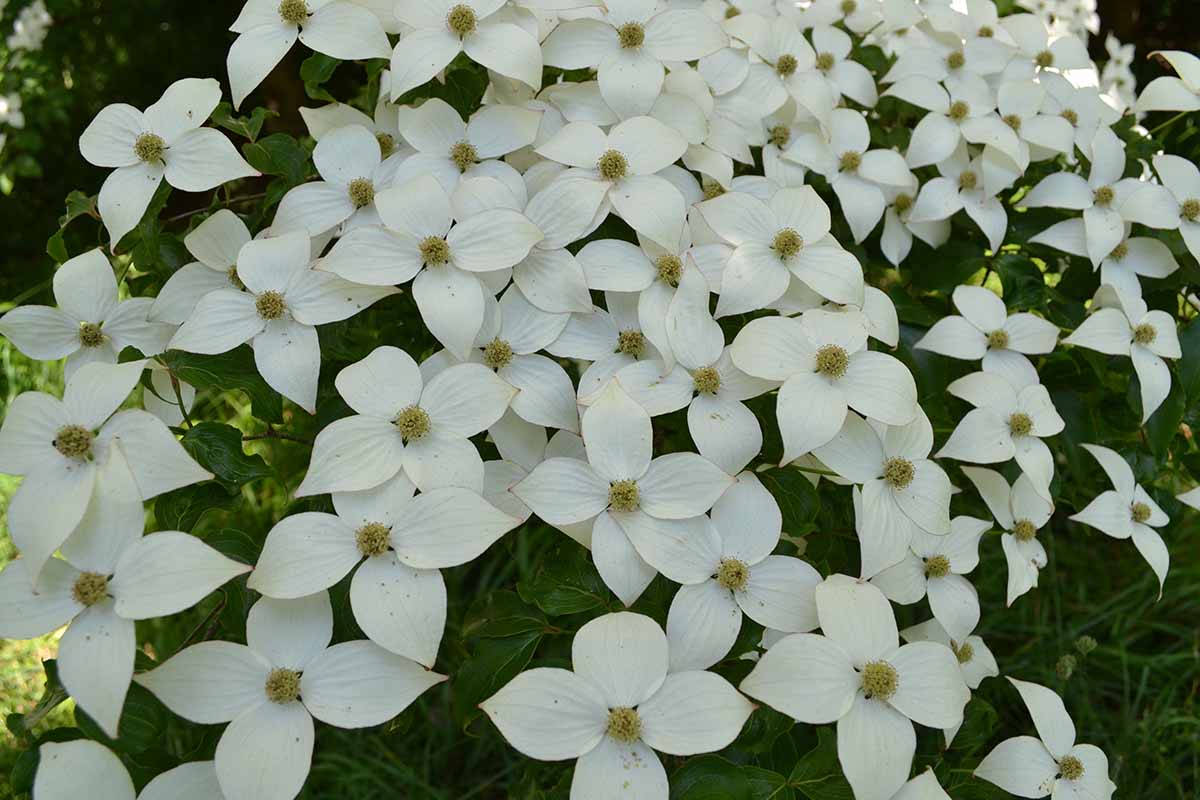
C. kousa has a multi-stemmed habit and reaches a mature height and spread of 15 to 30 feet.
The habit starts off vase-shaped and becomes more rounded with age, with prominently layered branching.
These branches form distinctly horizontal lines, which are attractive in winter and provide a fantastic contrast with the vertical lines of nearby structures.
The smooth and light brown young bark grays and peels with age, revealing mottled mosaics of tan, brown, and gray in the exfoliated patches. In general, this tree has a slow growth rate, especially when it’s young.
The simple, oppositely-arranged leaves are lance to oval shaped, with typical dogwood-style leaf veins that originate from the midrib and meet at the sharply-pointed leaf tips.
The mature leaf color is dark green, and changes shades of reddish-purple to scarlet in autumn.

Masses of small, insignificant, yellowish-green flowers bloom in late May to early June, surrounded by creamy white leaf bracts that are often confused for blossoms.
Four-pointed, football-shaped bracts encircle each cluster of true flowers, and these tend to pinken with age.
In late August to October, the flowers give way to attractive pinkish-red to red drupes, which resemble raspberries somewhat in both size and form.
These fruits are borne on skinny stems, which further advertise the tasty-looking fruits to birds and squirrels.
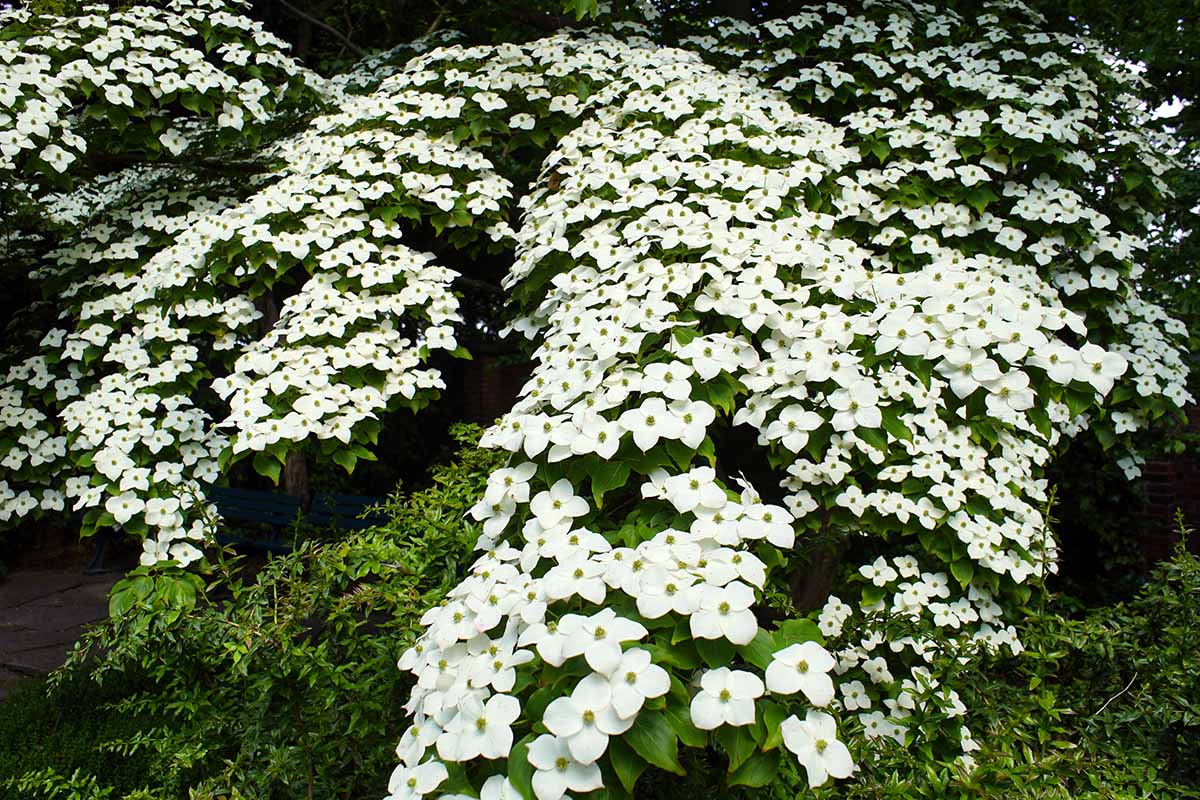
This tree has two subspecies: kousa and chinensis. The former is native to Japan and Korea, while the latter originates in China.
In general, the Chinese subspecies has a more freely growing habit and produces larger flowers than the other subspecies.
Cultivation and History
Originally found only in their Asian countries of origin, kousas are sometimes referred to by alternative common names such as Japanese, Japanese flowering, Korean, and Chinese dogwood.
First brought to the US around 1875, these trees are now common in cultivation here.
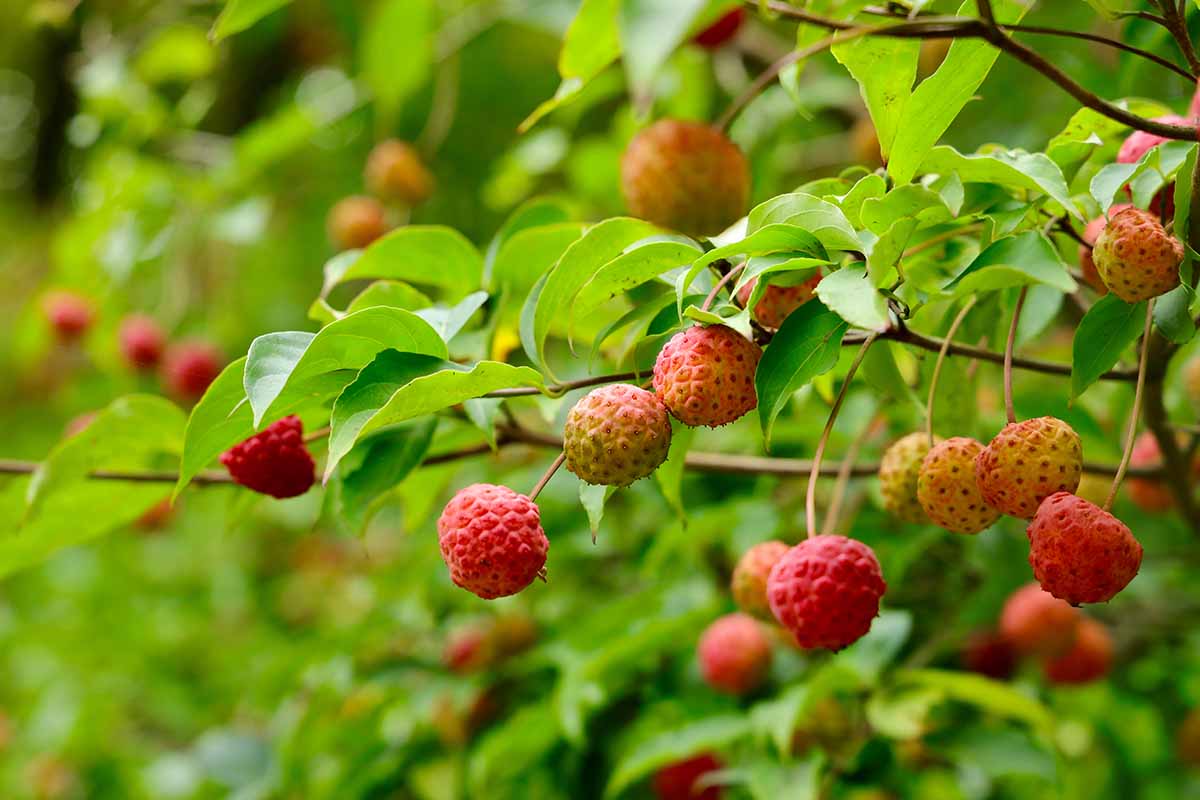
The kousa dogwood is resistant to pests and diseases that pose a great danger to C. florida, which makes it quite ornamentally valuable.
Breeding C. kousa with C. florida, when done successfully, can result in a hybrid cross that’s both beautiful and less prone to health problems.
Many kousa dogwood cultivars have entered the market, and a handful have received the Royal Horticultural Society’s prestigious Award of Garden Merit.
Along with its disease and pest resistance, C. kousa is valued in landscaping for its frost-resistance and relative cold hardiness.
Plus, this tree’s berries are edible for humans as well as animals.
Sure, the rind is bitter, and the seeds can be a bit inconvenient to eat around, but the pulp is delicious. It can be used for making jams and jellies, or even eaten raw.
Propagation
As with most species of Cornus, it’s best to propagate C. kousa from seed, by taking stem cuttings, or via transplanting.
These methods are listed here in order of descending difficulty. See our guide to growing flowering dogwood for general propagation information.
Propagating from seed definitely takes the longest, but the potential rewards are the greatest, since you could end up with a unique and desirable mutation.
Transplanting is best for those who have a ready-to-transplant specimen on hand and/or want a kousa dogwood ASAP, while cuttings are the middle-of-the-road option for folks who want to grow the plant from infancy, but wish to bypass the seed gathering, stratification, and germination steps.
Let’s touch on some specific aspects of kousa dogwood propagation, real quick.
First off, the fruits: rather than producing a cluster of red, olive-shaped berries that ripen in August like the flowering dogwood does, C. kousa has spherical, spiky fruits that hang from stems and finish ripening by mid-September.
Additionally, its seeds are a bit bulkier and more irregularly-shaped than those of C. florida.
It’s actually quite easy to pop open the fruits with your hands to get at the seeds within, which will need to be stratified for 120 days prior to sowing indoors.
Stem cuttings should be harvested in four-inch lengths from semi-hardwood shoots come summer, and given a basal dip of root hormone to speed up the rooting process before sticking in growing media, growing indoors, and hardening off outside come spring.
As far as transplants go, you’ll want to place them in fertile and well-draining planting sites, with a pH of 5.5 to 6.5.
Make sure the sites are situated at least 20 feet away from each other, and at least six feet away from natural hardscapes and man-made structures.
How to Grow
In my opinion, these trees are too gorgeous to grow in less-than-optimal conditions.
A kousa dogwood needs to be planted in USDA Hardiness Zones 5 to 8 for optimal growth and aesthetics. Additionally, it should ideally be situated in full sun.

Having said that, partial shade works as well. It’s also pretty cold- and frost-hardy for a Cornus, so don’t fret if your planting site toes the line between USDA Zones 4 and 5.
This tree needs to sit in well-draining soil that’s highly fertile, such as sandy loam. Mild acidity is another must, so aim for a pH somewhere in the 5.5 to 6.5 range.
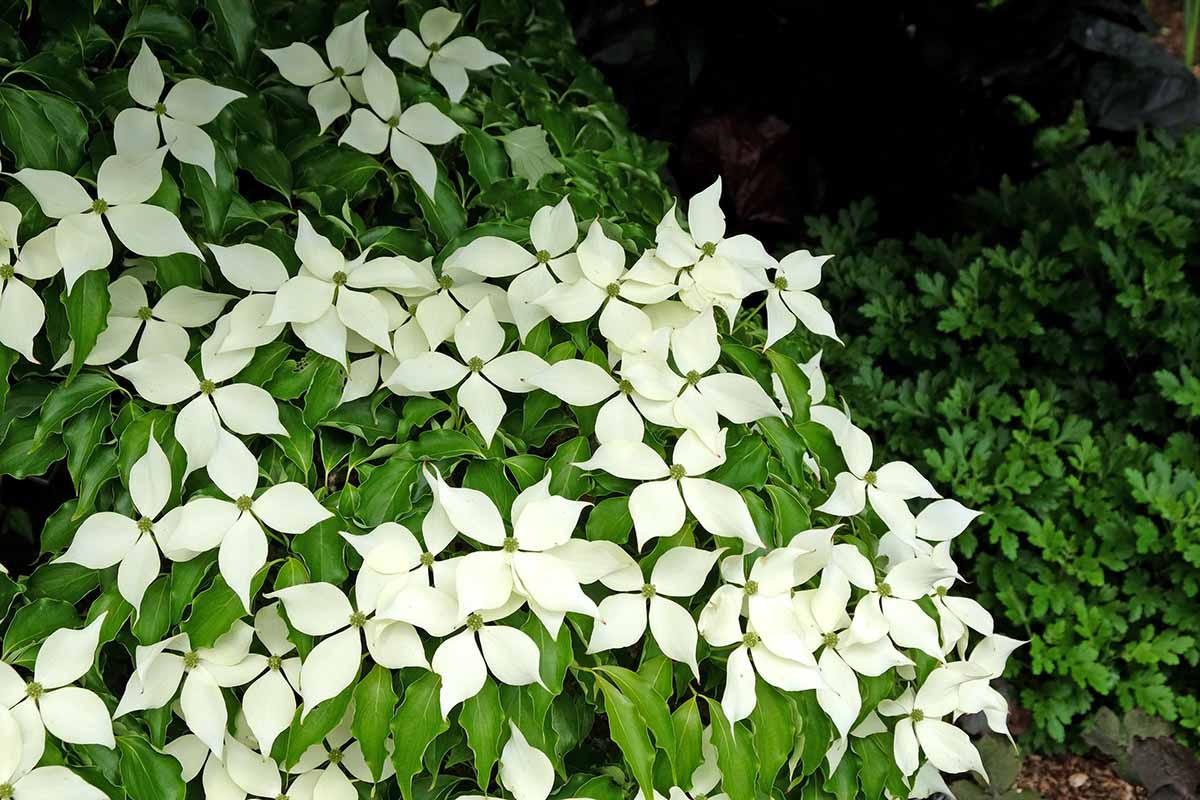
It’s best to maintain soil moisture by watering whenever the top inch of soil feels dry to the touch.
But this species is more drought-resistant once mature than most other kinds of Cornus, so don’t stress if you slack on the supplemental irrigation.
Adding a few inches of compost or well-rotted manure to the root zone in springtime will help to maintain soil fertility. You shouldn’t need to use supplemental fertilizer if you stay on top of these annual amendments.
Growing Tips
- Plant in USDA Hardiness Zones 5 to 8.
- Ensure a soil pH of 5.5 to 6.5.
- Whenever the top inch of soil feels dry, deeply irrigate the root zone.
Pruning and Maintenance
The natural-looking form of most dogwoods develops a beautiful shape on its own without the need for any pruning.
But it definitely helps the tree’s appearance and health to prune any branches that are damaged, dead, or sickly whenever you happen to notice them.
Minor annual pruning in the spring to remove rubbing, crossing, and obtrusive branches will increase airflow and improve aesthetics.
Rake up fallen leaves after they drop. Maintaining a two- to four-inch layer of mulch over the root zone without coming into contact with the trunk will help to suppress weed growth and prevent moisture loss.
Cultivars to Select
For a specimen to get you started, you can buy a kousa dogwood in a #1, #4, or #5 container from Nature Hills Nursery.
Alongside the standard species, some awesome cultivars are available today. Let’s explore a few.
Gold Star
A 20-foot-tall and 15-foot-wide cultivar of the chinensis subspecies, ‘Gold Star’ has leaves with a broad splash of yellow variegation running vertically down the center, red leaf stems, and the white bracts are a bit less pointed than those of the standard species.
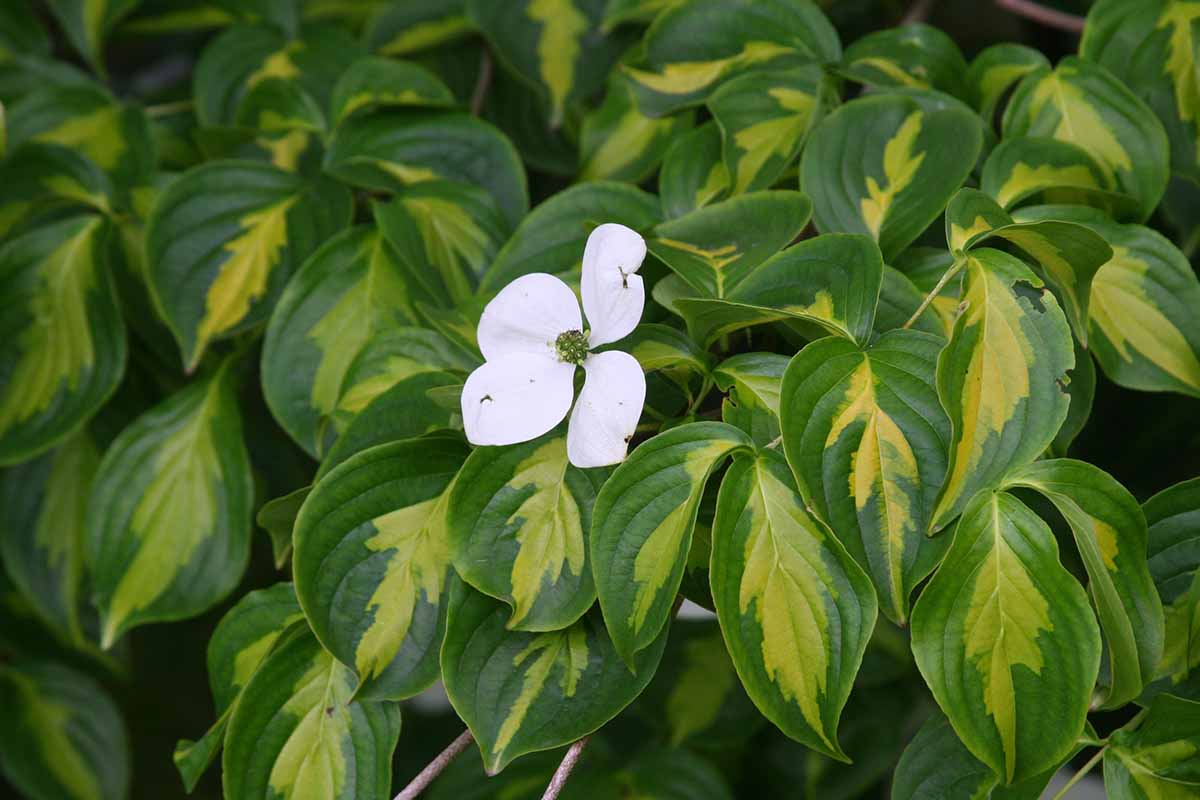
Come fall, the yellow variegation turns red, and the edges of the leaves morph to a reddish-purple hue.
With an overall droopy form to boot, ‘Gold Star’ earns its name in both beauty and distinction.
Milky Way
Another chinensis cultivar, ‘Milky Way’ has prolific and bright blooms, just like the stars in our galaxy.
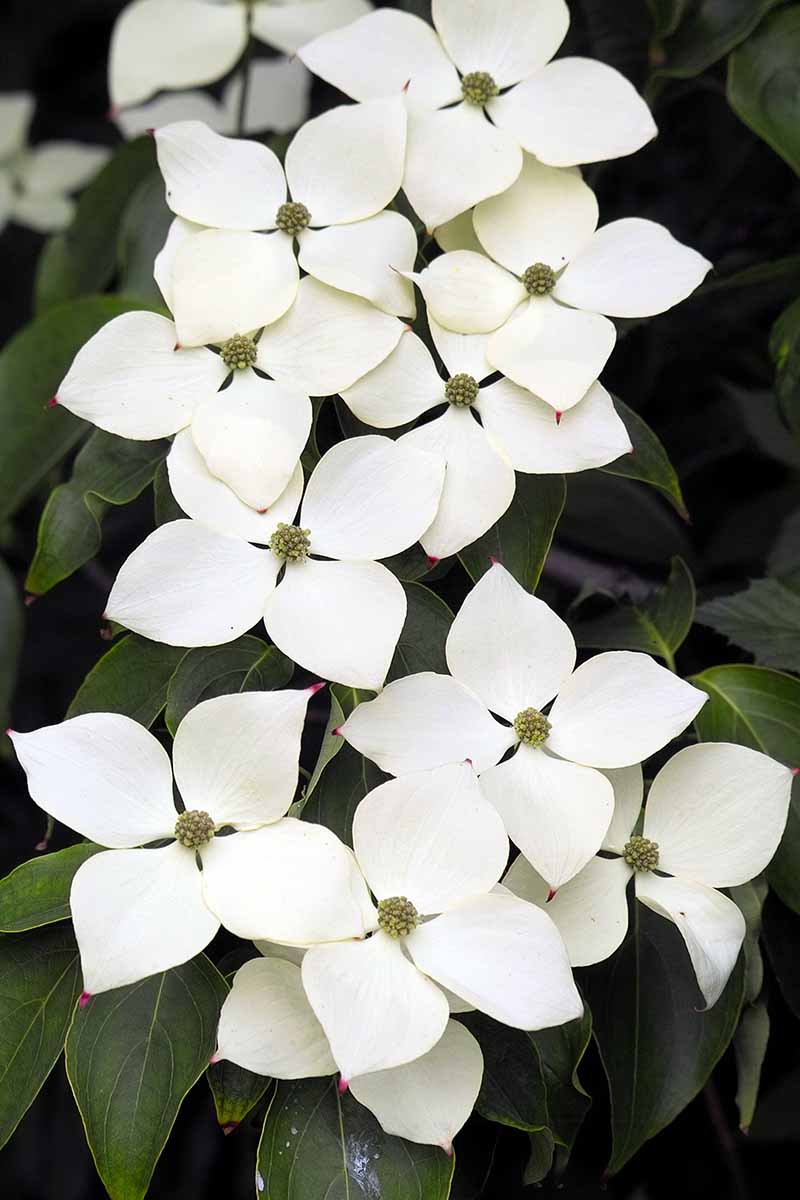
Attaining a 20-foot height and width at maturity, this variety flowers heavily in June, with leaves that turn shades of orange-red to scarlet in fall.
This cultivar produces large berries that mature in summer, and these persist long into late fall past the point of leaf drop. With its unparalleled flowering, ‘Milky Way’ is not a variety to ignore.
Miss Satomi
Also sold under the trade names ‘Rosabella’ and ‘New Red,’ ‘Miss Satomi’ has beautiful, rose-colored leaf bracts, and reaches a height of 12 to 15 feet with a 10- to 12-foot spread when fully grown.
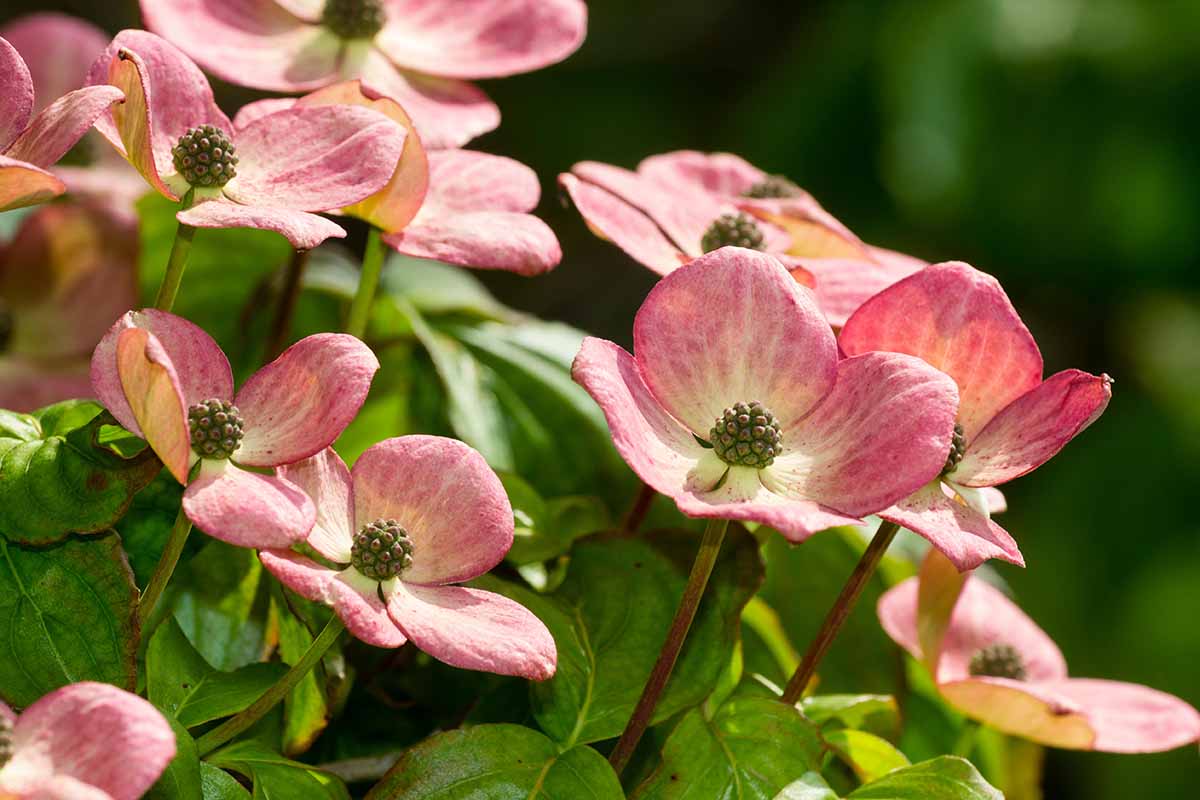
This variety is an awesome choice for those who seek a change from the usual white “blooms.” Plus, ‘Miss Satomi’ was a 1993 winner of the RHS Award of Garden Merit!
Moonbeam
Want size over quantity? With ‘Moonbeam,’ you’ll have flowers twice as big as those of the standard species, with each bloom measuring seven to eight inches in diameter.
At a mature height and width of 15 to 25 feet, ‘Moonbeam’ proves that bigger (flowers) sometimes are better.
Wolf Eyes
Even though C. kousa is already a small understory tree, ‘Wolf Eyes’ is even smaller, topping out at 15 feet in height and width.
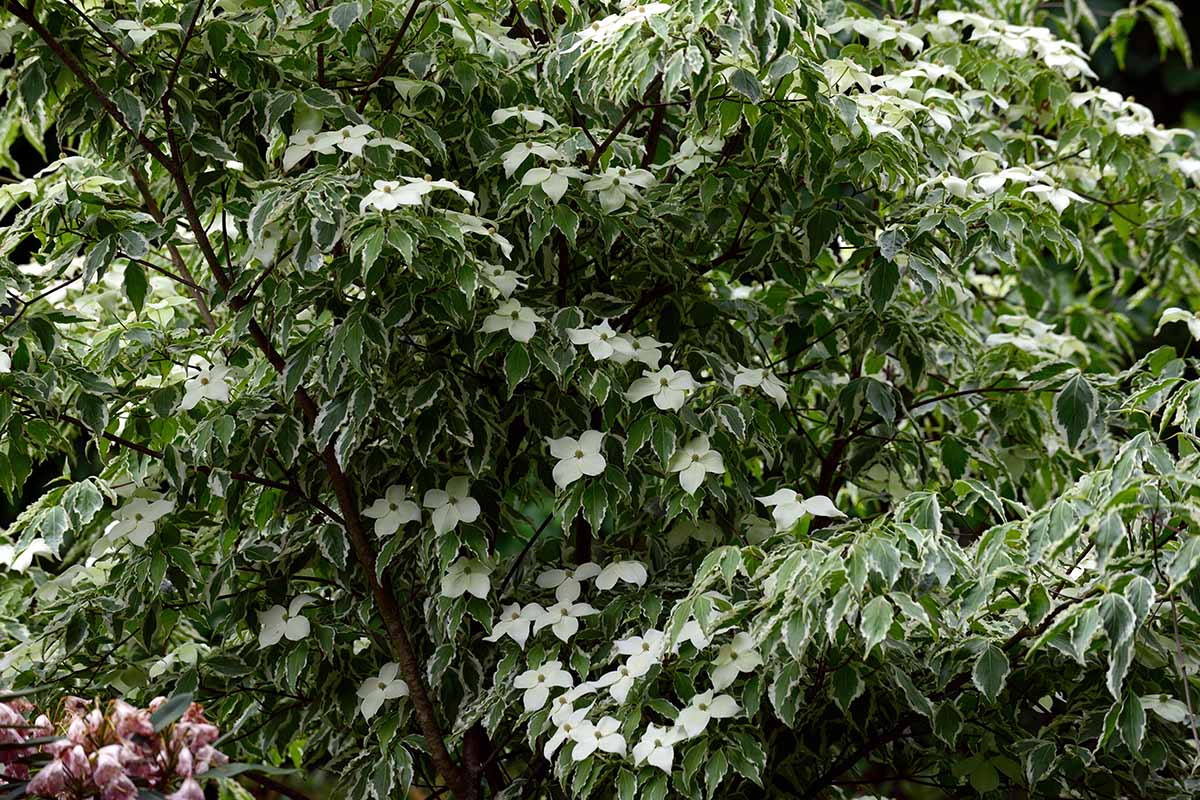
Along with its diminutive size, ‘Wolf Eyes’ flaunts leaves edged with white that turn a stunning pink to red in fall.
This variegation in the foliage is quite stable, and the leaves are less likely to burn than those of other variegated types of Cornus.
This plant is slow-growing, and actually prefers partial shade to full sun.
Another recipient of the RHS Award of Garden Merit, granted in 2012, ‘Wolf Eyes’ fits in the shaded, tight spaces of gardens where other trees won’t – and does it with style.
Managing Pests and Disease
One of the best traits of C. kousa is its resistance to pests and pathogens.
Common Cornus issues such as anthracnose, powdery mildew, and dogwood borer infestations are not a problem for this tree.

Using sterilized gardening tools, disease-free plants, and clean soil are all wise ways of preventing potential problems, of course.
Selecting cultivars renowned for their resilience is another smart strategy.
But for the most part, a C. kousa doesn’t require the concern over infestation and infection that, say, a C. florida specimen would.
Be sure to select an appropriate planting site with adequate sun exposure and soil drainage to avoid issues with rot, and to promote flowering.
Best Uses
Kousa dogwood is gorgeous enough to pose as a specimen in the landscape – it’s a one-plant show.
But when planted in multiples and arranged in a line, these trees make for a solid and aesthetic border. It’ll certainly look better than a wall or fence, if I do say so myself!

As a foundation planting, this tree’s horizontal branching pairs quite nicely with the vertical lines formed by the corners and edges of buildings, making the man-made structures somehow appear larger.
And it goes without saying that a C. kousa is the perfect planting for those who want the dogwood aesthetic sans any significant pest and disease risk.
Quick Reference Growing Guide
| Plant Type: | Deciduous flowering tree | Flower/Foliage Color: | Golden yellow, white/dark green |
| Native to: | China, Japan, Korea | Maintenance: | Moderate |
| Hardiness (USDA Zones): | 5-8 | Tolerance: | Cold, deer, dogwood anthracnose, dogwood borers, frost, powdery mildew |
| Bloom Time: | May to June/late spring to early summer | Soil Type: | Moist, fertile |
| Exposure: | Full sun to partial shade | Soil pH: | 5.5-6.5 |
| Time to Maturity: | 5-7 years | Soil Drainage: | Well-draining |
| Spacing: | 20 feet apart, 6 feet from structures | Attracts: | Bees, other pollinating insects, songbirds, squirrels |
| Planting Depth: | 1/2 inch (seeds), depth of root system (transplants) | Uses: | Border, foundation planting, specimen |
| Height: | 15-30 feet | Family: | Cornaceae |
| Spread: | 15-30 feet | Genus: | Cornus |
| Water Needs: | Moderate | Species: | Kousa |
| Common Pests and Diseases: | Root rot | Subspecies: | Chinensis, kousa |
Bark up the Right Tree
As a tree enthusiast, it pains me to say this… but not every tree should be planted. Like a Bradford pear tree, for instance.
Planting a species known today to be invasive throughout most parts of the US would be a total mistake, just like misinterpreting a bartender’s friendliness for flirtatiousness.
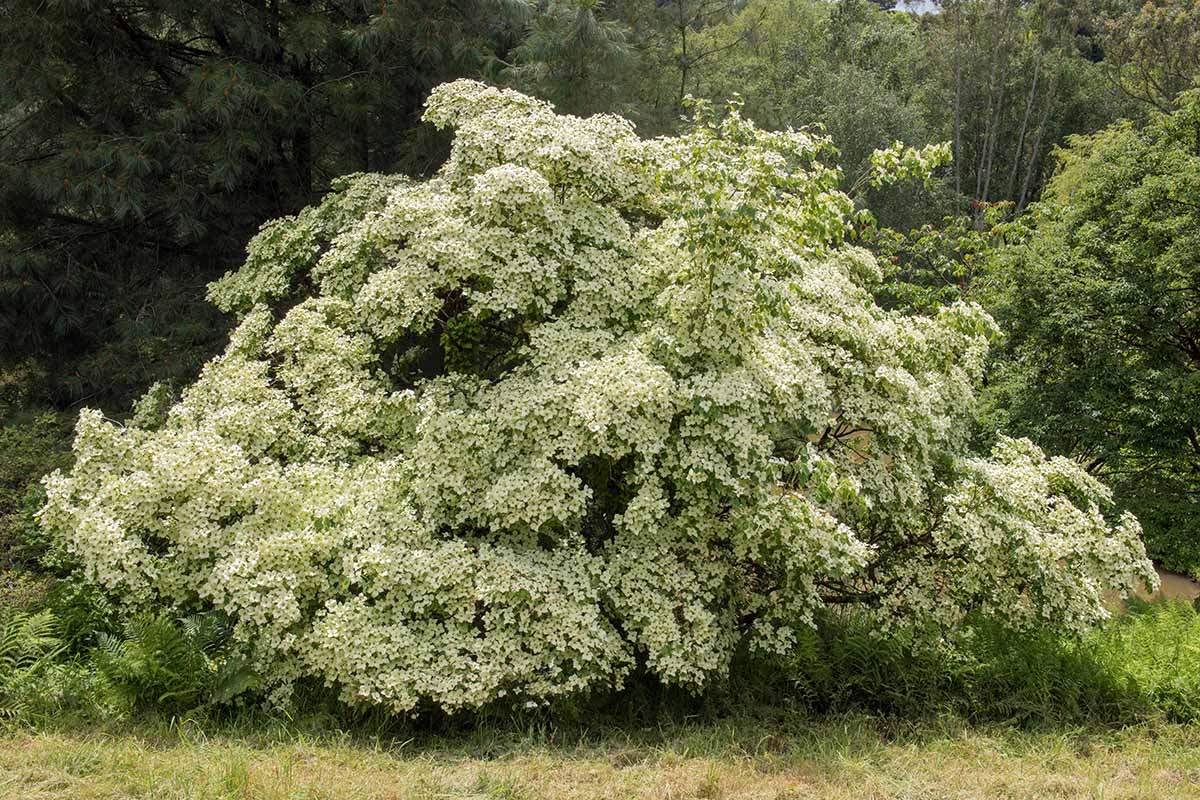
But I’m confident in saying that the kousa dogwood is definitely worthy of a spot in your landscape if you live in a suitable Hardiness Zone. Its beauty and resilience are enough to earn it a place in your garden.
Have questions, concerns, or remarks to share? Put ’em in the comments section below!
Interested in growing other types of landscape trees? Have a look at these guides next:
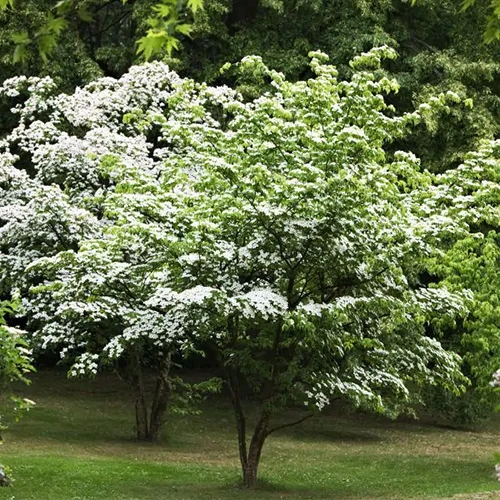
Hello!
How do I remove the runners from around my Kousa Dogwood tree? Am wanting to put in a circular flower bed around trunk, but notice tree shoots coming up!
Great question, Peach! Simply pruning the suckers all the way down to their bases with sterile hand pruners as they become visibly apparent should suffice. Spring pruning tends to trigger vigorous regrowth more so than summer pruning, so waiting until summertime could indirectly limit the amount of pruning you have to do… but I suppose that’ll leave you with longer suckers up until that point. It’s up to you!
Would Hybridizing Cornus kousa with Cornus florida make the Fruits not Edible? Is this something I have to Worry about When Growing Kousa Dogwood from seed to Breed my own New Edible Varieties of Kousa Dogwood? Or do the 2 species not Hybridize easily? Also any good Cultivars that are bred for the fruit? Any Good Tasting Cultivars?
Hello, Eric… thanks for asking such interesting questions! Hybrids of Cornus kousa and Cornus florida are pretty much always sterile and fruitless, so I wouldn’t sweat it. But if fruits happen to form (they’ll look like a cluster of mini-drupses/ an intermediate of their parents’ fruits), I wouldn’t consume any, since Cornus florida fruits are poisonous to humans. But in the context of breeding Kousa dogwoods for fruits, I wouldn’t worry about it, as the two species don’t really hybridize with each other naturally (not without human intervention, anyway). Taste is pretty subjective, but ‘Big Apple,’ ‘Julian,’ and ‘National’ are… Read more »
My Kousa Dogwood is next to a large pine tree. It gets mostly morning sun around 4-5 hours. Is this enough sunlight?
Absolutely, Cheryl. That’s A-okay sun exposure!
I had two of these beautiful trees planted about two years ago. This year one is loaded with your typical blooms and the other looks perfectly healthy but no blooms?? What could be going on?
Hi, Susan! That’s an interesting issue you’re having. Assuming that the trees are the same species and variety, I suppose the first step would be to try and figure out the differences between your kousa dogwoods in terms of how they’re cultivated, what their environments are like, etc. It sounds like they’re the same age… do they receive different sunlight exposures? Are they situated in different microclimates within your garden? Are they sitting in different kinds of soil (texture, organic matter, drainage, pH, etc.)? Is one receiving more or less irrigation than the other? If the non-flowering one is sitting… Read more »
I’m thinking now they may be different varieties! Thanks for your in-depth analysis!!!
I just purchased a 5 foot Kousa Dogwood that I planted & I live in Mississippi- The Kousa dogwood will be getting sun from around 3:00 p.m to 6:00 p.m, the remainder of the day, it will be shaded, with some filtered sun. Will these conditions be acceptable for the tree? Thank you
Hi, Debbie! Yes, that should suffice. Its flowering might not be as abundant as it would with 4 to 6 hours of sun per day, but your tree will definitely be alright.
Hi Joe- Thank you for your reply- Wasn’t sure if 3-6 p.m. in Mississippi hot sun would be too harsh on the tree. We have alot of humidity, and it also can get into the high 90’s later in the summer. I read that the Kousa Dogwood can get sun scorched. I do have mulch around the tree, and I am reading the moisture content, and keeping the tree well watered. I would have liked to put the tree in just morning sun, however, That wasn’t available at my house.
Understandable. The tree receiving only three hours of afternoon sun, with shade/dappled sun the rest of the time, is an interesting scenario.
Afternoon sun is typically harsher than morning sun, though, so make sure to keep the tree well-watered and well-mulched. Also make sure to keep an eye out for leaf scorch, especially in summer.
Also, I should have clarified this earlier: kousa dogwoods have a USDA Hardiness Zone range of 5 to 8, so if you’re located in Zone 9 in southern Mississippi, long-term growing success may be a real struggle.
Hi Joe, I am actually located in Zone 8- Pearl, MS-39208. I am keeping my fingers crossed that the tree will be able to handle the sun from 3:00-6:00- I noticed yesterday that it does have a little filter from my Oak Tree around 5:30, which I have placed it Kind of Under. The tree will be well watered & mulched, and hoping everything will be well. Thank You for your advice.
No problem, Debbie! Let us know how things go!
Hello! My CornusKousa Chihnensis Multi was planted 2 years ago. Doing well. But I have noticed a few smaller dark branches on one of the main stems with no growth. However, that same main stem has plenty of growth on top? Should I prune or just leave it for now? Thank you.
Howdy, Mary! Honestly, it’s up to you. I personally prefer to prune dead branches as soon as I see them, as they can be a health risk. But it doesn’t sound like those dark branches are huge health vulnerabilities for the tree at the moment, so you could probably just wait until your next major pruning session, if you so desire.
I just planted my new Kousa Dogwood in the spring of 2022. It did well the first summer and the leaves stayed on it through the winter. Unfortunately we had late killing frosts in Mishawaka, Indiana and I didn’t know I should have covered the tree. Now it only has a few leaves on one side but a lot of suckers coming up from the base. I don’t want to lose the tree, so my question is do I just wait to see if it gets more leaves next year of trim it down to the new growth coming from… Read more »
Hey, Judy! Yeah, waiting to see if the tree bounces back won’t hurt, especially after all the trimming you did. If you don’t mind me asking, how large is your tree?
It is about 4 ft tall at this point.
Would this do well in zone 9-10?
Hey, Barbara! No, I don’t think USDA Zones 9-10 would be cool enough for the tree to do well. If you created a cooler microclimate in a Zone 9 garden, maybe it could work. But it would definitely be an tough uphill battle to grow the tree.
I’d like to plant if I can find one locally a Kousa Dogwood – what size could I look for that would give me blossoms sooner rather than later (I’m elderly-lol)
Hey Claire! When it comes to flowering, reaching a mature age is more important than size (although size can be an indication of age). I guess you should look for the largest, most mature transplant that you can find. That should eliminate as much wait time as possible.
My C. Kousa was planted this Spring and now has browning leaf edges. It has been kept well-watered. What fertilizer is recommended for it?
Hey, Bruce! Assuming that this is a nutritional issue and not a result of too much water (which can manifest as leaf browning), this could be a sign of a potassium deficiency.
So along with annual additions of a humus such as compost, you’ll also want to select a slow-release, NPK fertilizer that doesn’t skimp out on the K. If possible, go for organic over synthetic, as organics will provide trace amounts of micronutrients that synthetics won’t.